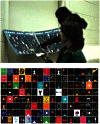A cross-species study of gesture and its role in symbolic development: implications for the gestural theory of language evolution
- PMID: 23750140
- PMCID: PMC3674957
- DOI: 10.3389/fpsyg.2013.00160
A cross-species study of gesture and its role in symbolic development: implications for the gestural theory of language evolution
Abstract
Using a naturalistic video database, we examined whether gestures scaffold the symbolic development of a language-enculturated chimpanzee, a language-enculturated bonobo, and a human child during the second year of life. These three species constitute a complete clade: species possessing a common immediate ancestor. A basic finding was the functional and formal similarity of many gestures between chimpanzee, bonobo, and human child. The child's symbols were spoken words; the apes' symbols were lexigrams - non-iconic visual signifiers. A developmental pattern in which gestural representation of a referent preceded symbolic representation of the same referent appeared in all three species (but was statistically significant only for the child). Nonetheless, across species, the ratio of symbol to gesture increased significantly with age. But even though their symbol production increased, the apes continued to communicate more frequently by gesture than by symbol. In contrast, by 15-18 months of age, the child used symbols more frequently than gestures. This ontogenetic sequence from gesture to symbol, present across the clade but more pronounced in child than ape, provides support for the role of gesture in language evolution. In all three species, the overwhelming majority of gestures were communicative (i.e., paired with eye contact, vocalization, and/or persistence). However, vocalization was rare for the apes, but accompanied the majority of the child's communicative gestures. This species difference suggests the co-evolution of speech and gesture after the evolutionary divergence of the hominid line. Multimodal expressions of communicative intent (e.g., vocalization plus persistence) were normative for the child, but less common for the apes. This species difference suggests that multimodal expression of communicative intent was also strengthened after hominids diverged from apes.
Keywords: communication development; cross-species comparisons; gestural theory of language evolution; gesture; language development; language-enculturated apes; symbolic development.
Figures












References
-
- Armstrong D. F. (2008). The gestural theory of language origins. Sign Lang. Stud. 8, 289–31410.1353/sls.2008.0005 - DOI
-
- Armstrong D. F., Wilcox S. E. (2007). The Gestural Origin of Language. Oxford: Oxford University Press
-
- Bates E., Camaioni L., Volterra V. (1975). Performatives prior to speech. Merrill Palmer Q. 21, 205–226
-
- Blake J., McConnell S., Horton G., Beson N. (1992). The gestural repertoire and its evolution over the second year. Early Dev. Parent. 1, 127–13610.1002/edp.2430010302 - DOI
LinkOut - more resources
Full Text Sources
Other Literature Sources
Research Materials
Miscellaneous

